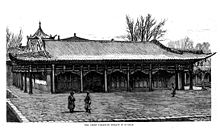Taranchi

Taranchi is a term denoting the Muslim sedentary population living in oases around the Tarim Basin in today's Xinjiang, whose native language is Turkic Karluk, and whose ancestral heritages include Iranic and Tocharian populations of Tarim and the later Turco-Mongol immigrants of the Qarluq, Yaghma, Chigils, and Mongol tribes.
The same name – which simply means 'a farmer' in Chagatai – can be extended to agrarian populations of the Ferghana Valley and oases of the entire Central Asian Turkestan. Although the Tarim Basin (with such oases as Kashgar, Kumul, Khotan and Turpan) is the agrarian Taranchis' traditional homeland, they have throughout the Ming and Qing periods of China, populated regions that are now Urumqi and Ili. Many Taranchis were encouraged to settle in the Ili valley alongside sedentary Xibe garrisons and the nomadic Kyrgyz by the Qing military governors after the conquest of the Dzungars by the Chinese. In the multiethnic Muslim culture of Xinjiang, the term Taranchi is considered contradistinctive to Sart, which denotes towns dwelling traders and craftsmen. It of course excluded the ruling classes of the oases Muslim states, often called Moghol/Mughal or Dolan because of the Doglat Mongol origin of the Chagatay-Timurid dynasties. However, from a modern perspective, Taranchi, Sart and Moghol Dolans cannot be considered three distinctive ethnic groups, but rather three different classes or castes in the same cultural-linguistic zone that was Chagatay-Timurid.
In the early 20th century, the geopolitical Great Game between Russia and Great Britain resulted in the division of Central Asia among modern nation-states. All oases farmers native to Xinjiang became part of Uyghur nationality by 1934. It is interesting to note that while most Sarts of oases or Ili Valley towns became part of the Uyghur nationality, those with particularly strong ties to regions west of Xinjiang became Uzbeks. Sometimes such divisions are very arbitrary, because Kashgaris can be as distinctive from Turpanliks as they are from Andijanliks.
The Taranchi revolted against the Qing dynasty during the Dungan revolt. At first, they cooperated with the Dungans, but turned on them, massacring the Dungans at Kuldja and driving the rest through Talk pass to the Ili valley.[1]
References
- ^ Great Britain. Parliament. House of Commons (1871). Accounts and papers of the House of Commons. Ordered to be printed. p. 35. Retrieved 2010-06-28.
![]() This article incorporates text from Accounts and papers of the House of Commons, a publication from 1871, now in the public domain in the United States.
This article incorporates text from Accounts and papers of the House of Commons, a publication from 1871, now in the public domain in the United States.
